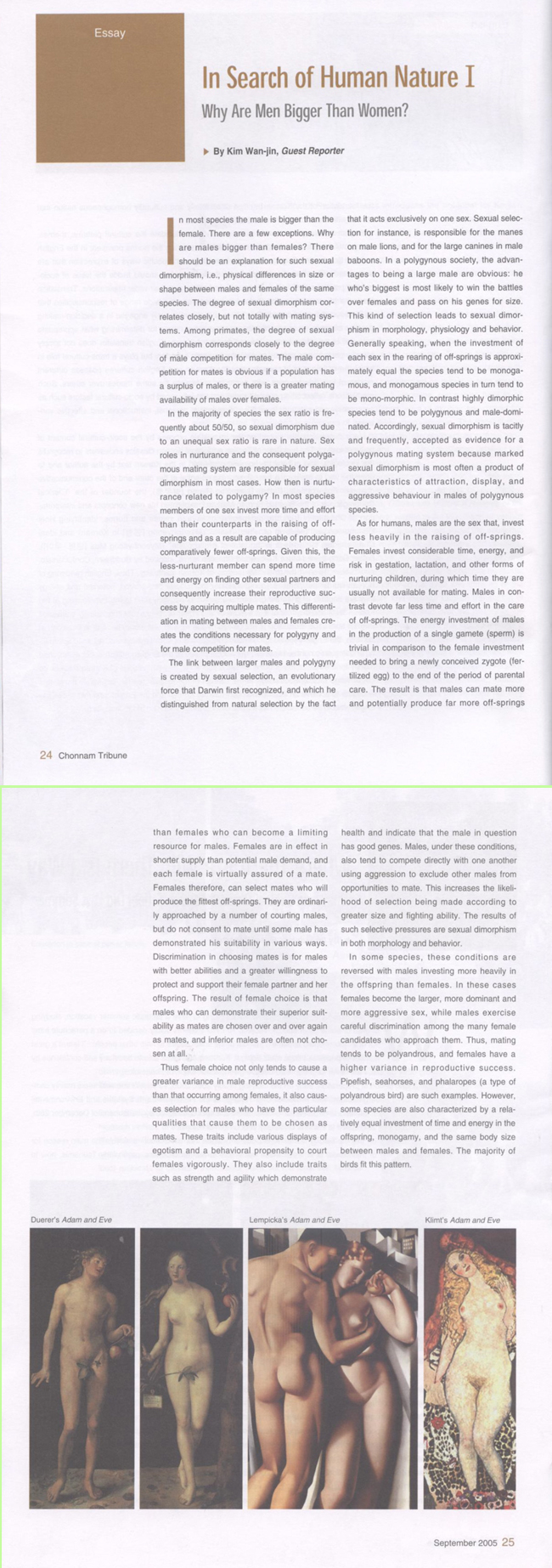
In Search of Human NatureⅠ
Why Are Men Bigger than Women?
By Kim Wan jin, Guest Reporter
In most species the male is bigger than the female. There are a few exceptions. Why are males bigger than females? There should be an explanation for such sexual dimorphism, i.e., physical differences in size or shape between males and females of the same species. The degree of sexual dimorphism correlates closely, but not totally with mating systems. Among primates, the degree of sexual dimorphism corresponds closely to the degree of male competition for mates. The male competition for mates is obvious if a population has a surplus of males, or there is a greater mating availability of males over females.
In the majority of species the sex ratio is frequently about 50/50, so sexual dimorphism due to an unequal sex ratio is rare in nature. Sex roles in nurturance and the consequent polygamous mating system are responsible for sexual dimorphism in most cases. How then is nurturance related to polygamy? In most species members of one sex invest more time and effort than their counterparts in the raising of off-springs and as a result are capable of producing comparatively fewer off-springs. Given this, the less-nurturant member can spend more time and energy on finding other sexual partners and consequently increase their reproductive success by acquiring multiple mates. This differentiation in mating between males and females creates the conditions necessary for polygyny and for male competition for mates.
The link between larger males and polygyny is created by sexual selection, an evolutionary force that Darwin first recognized, and which he distinguished from natural selection by the fact that it acts exclusively on one sex. Sexual selection for instance, is responsible for the manes on male lions, and for the large canines in male baboons. In a polygynous society, the advantages to being a large male are obvious: he who's biggest is most likely to win the battles over females and pass on his genes for size. This kind of selection leads to sexual dimorphism in morphology, physiology and behavior. Generally speaking, when the investment of each sex in the rearing of off-springs is approximately equal the species tend to be monogamous, and monogamous species in turn tend to be mono-morphic. In contrast highly dimorphic species tend to be polygynous and male-dominated. Accordingly, sexual dimorphism is tacitly and frequently, accepted as evidence for a polygynous mating system because marked sexual dimorphism is most often a product of characteristics of attraction, display, and aggressive behaviour in males of polygynous species.
As for humans, males are the sex that, invest less heavily in the raising of off-springs. Females invest considerable time, energy, and risk in gestation, lactation, and other forms of nurturing children, during which time they are usually not available for mating. Males in contrast devote far less time and effort in the care of off-springs. The energy investment of males in the production of a single gamete (sperm) is trivial in comparison to the female investment needed to bring a newly conceived zygote (fertilized egg) to the end of the period of parental care. The result is that males can mate more and potentially produce far more off-springs than females who can become a limiting resource for males. Females are in effect in shorter supply than potential male demand, and each female is virtually assured of a mate. Females therefore, can select mates who will produce the fittest off-springs. They are ordinarily approached by a number of courting males, but do not consent to mate until some male has demonstrated his suitability in various ways. Discrimination in choosing mates is for males with better abilities and a greater willingness to protect and support their female partner and her offspring. The result of female choice is that males who can demonstrate their superior suitability as mates are chosen over and over again as mates, and inferior males are often not chosen at all.
Thus female choice not only tends to cause a greater variance in male reproductive success than that occurring among females, it also causes selection for males who have the particular qualities that cause them to be chosen as mates. These traits include various displays of egotism and a behavioral propensity to court females vigorously. They also include traits such as strength and agility which demonstrate health and indicate that the male in question has good genes. Males, under these conditions, also tend to compete directly with one another using aggression to exclude other males from opportunities to mate. This increases the likelihood of selection being made according to greater size and fighting ability. The results of such selective pressures are sexual dimorphism in both morphology and behavior.
In some species, these conditions are reversed with males investing more heavily in the offspring than females. In these cases females become the larger, more dominant and more aggressive sex, while males exercise careful discrimination among the many female candidates who approach them. Thus, mating tends to be polyandrous, and females have a higher variance in reproductive success. Pipefish, seahorses, and phalaropes (a type of polyandrous bird) are such examples. However, some species are also characterized by a relatively equal investment of time and energy in the offspring, monogamy, and the same body size between males and females. The majority of birds fit this pattern.

